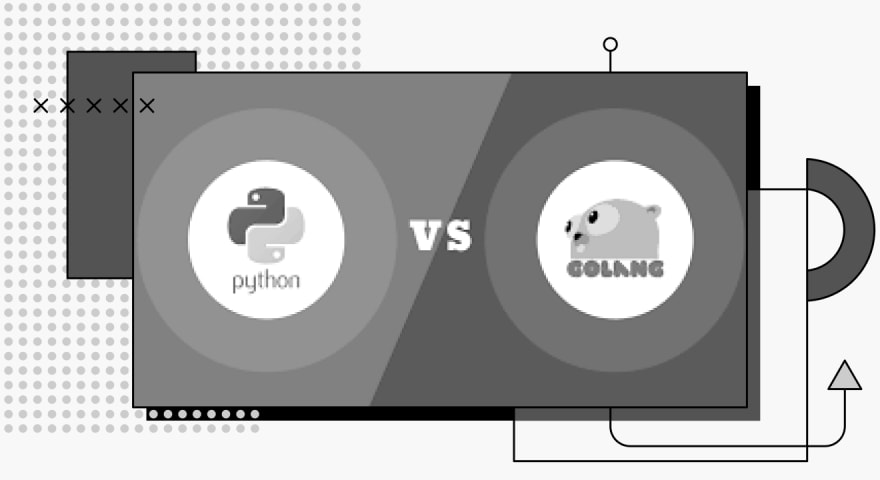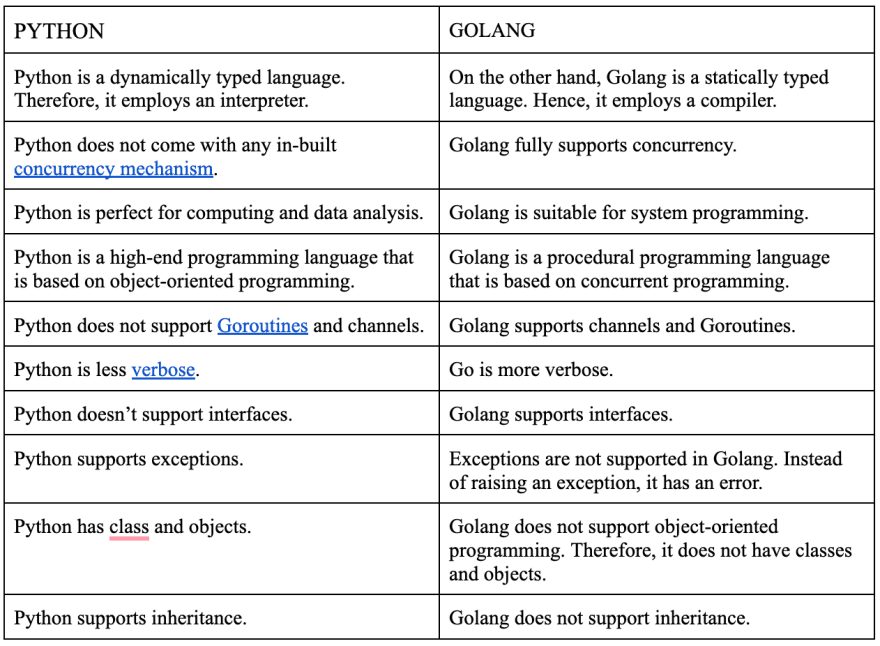It’s old news that Python tops the list as the most popular programming language while Golang fights to stay in the top ten with PHP, Kotlin, C and so on. This is because we commonly use Python for software development, task automation, data analysis, data visualization, AIs and building websites or applications like Instagram. In addition, Python - being relatively easy to learn - has been adopted by many non-programmers, like accountants and scientists, for various everyday tasks like organizing finances.
Golang, on the other hand, is helpful for scalable programming servers and large software systems. The Google developers built Golang to fill in the gaps between C++ and Java that Google unearthed while working with its servers and distributed systems.
Python vs Golang: Fundamentals
What is Python?
Python is a very sought-after, high-level programming language with a general purpose. Its design philosophy emphasizes code readability with the use of significant indentation. Python is dynamically typed and garbage collected, and supports multiple programming paradigms including structured, object-oriented and functional programming.
Python is also an interpreted, object-oriented, high-level programming language with dynamic semantics. Combining the high-level build in data structures with dynamic typing and binding makes it very appealing for swift application development and as a scripting or cementing language to connect existing components. Python has an easy-to-learn syntax that highlights readability and narrows the cost of maintaining a program. Python supports modules and packages, which motivates program modularity and code reuse. The Python interpreter and the extensive standard library are accessible in source or binary form without charge for all major platforms making it free to distribute.
What is Python used for?
Python is used to create various programs and isn't specialized for specific problems. For example, we can use Python for data analytics, AI and machine learning, web scraping and data visualization.
Programming applications
You can program all kinds of applications with Python. You can use this general-purpose language to read and create file directories, GUIs, APIs, and more. You can build them all with Python, whether blockchain applications, audio and video apps or machine learning applications.
Game development
It's feasible to create simple games using the programming language, which can be helpful in quickly developing a prototype.
Language development
Python's simple and elegant design and syntax have inspired the creation of new programming languages like Cobra, CoffeeScript, and Go, all using a similar syntax to Python.
This highlights that Python is a valuable blueprint language. So, if you're a newbie in programming, understanding Python can help you easily branch out into other areas.
Finance
It is a valuable tool in deciding asset price trends and predictions and automating workflows across different data sources.
SEO
This area often benefits from automation, which is possible through Python. Whether implementing changes across multiple pages or categorizing keywords, Python will assist you.
Design
You can use Python to develop graphic design applications. Surprisingly, the language is used across 2D imaging software, like Gimp.
Python is also used in 3D animation software such as Lightwave, Blender and Cinema 4D.
What is Golang?
Golang is a procedural, statically typed and compiled programming language created by Google developers Robert Griesemer, Rob Pike, and Ken Thompson. They started Golang because complexity was increasing in the codebases within Google, and they didn’t fancy C++. Golang was publicly announced in 2009, and it was made an open-source language in 2012 with the release of its first version.
Golang quickly became popular and many developers’ first choice because of its simplicity, efficiency and ability to run multiple tasks simultaneously.
Golang is used for server-side (backend) programming, game development, cloud-based programming and even data science. It’s pretty famous for making command-line tools.
Today, many people in tech use Golang, including developers at Google, Netflix, Twitch, Ethereum, Dropbox and so on.
Unsurprisingly, Kubernetes, Docker and Heroku are using Golang because cloud-based programming is one of the main reasons Golang was designed.
What is Golang used for?
The reason why Google created Golang is to clear up software issues of scalability, where resources are limited by hardware. In other words, it’s convenient when it addresses bottleneck issues in processing time.
Usually, late-stage startups and other large companies with many users will have issues wherein the backend finds it challenging to cope with the volume of activities. Golang’s support for coexisting functions and small memory footprint is a perfect fit for backend development where servers must deal with substantial requests.
Dropbox, a cloud-storage sharing service, uses Golang to efficiently manage more than 500 million users on its network. Golang is also ideal for building e-commerce sites that handle millions of monthly visits.
Pros and Cons of Python and Golang
As both languages have their benefits, they also have drawbacks that should be considered.
Python Pros
- Beginner-Friendly: Python can be an excellent first step for beginners who want to explore coding. It’s proportionately easy to learn because it does not comprise too many technicalities, given its simple syntax.
- Thriving Community: In Python, you can seek help from developers with experience and knowledge. The Python community has many coders, developers, professionals and students on the same platform who help each other.
- Flexible and Extensible: Python is highly flexible and can be extended to other languages. For example, developers can write code in C and C++ and build new features in the dynamically typed language.
- Embeddable: Python is extensible, and you can write most of its code in other languages, such as C++. This lets us add scripting capabilities to our code in different languages.
- Machine Learning: Python is the perfect choice when your business needs web projects to be integrated with Machine Learning algorithms. Web Projects that need Python use it because it provides rich libraries, making it easier for developers to work with data.
Python Cons
- Python is a Dynamically Typed language: Developers in Data Science and Machine Learning projects often prefer statically typed languages over dynamically typed language because the statically typed language potentially minimizes many errors and bugs in the system.
- Python collects garbage, which consumes memory: Python uses a lot of memory, and developers using Python should carefully tackle the high memory consumption during the project. In addition, it uses reference counting in its garbage collection, which often leads to potential memory loss.
- Weak Security: Python is not 100% secure. Therefore, you must do things to certify that the code is safe, such as conducting the right QA testing.
- Python has issues with Design: Sometimes, Python developers have to deal with complicated designs, which are better suited to experienced developers than beginners.
- Slower than Compiled Languages: Python is slower than non-compiled languages because it requires a lot of computational power.
Golang Pros
- Speed: It can compile straight-to-machine code. As a result, programs based in Golang are super fast and compile quickly.
- Functioning developer community: You can get quick and reliable support from the strong and active Golang community.
- Comprehensive tool: Golang has a lot of tools to support development, even though it's not as vast as Java. Go comes with comprehensive tools that make coding easy for developers.
- Highly Scalable: Scalability is often essential when picking a project's programming language. Golang offers greater scope for scalability.
- Easy to learn: Golang is not a programming language that takes months to pick up. You can get through the syntax quickly if you are a beginner. The code structure of Golang is similar to C. Golang doesn't overwhelm learners with complicated syntax or variables, and it is easy to solve issues once you know the primary Golang language.
Golang Cons
- Golang in the early stage of a startup is a bad idea. Golang isn't something you'll want to choose if your business is still verifying its concept. It's not applicable to quickly craft a demo for investors. The time and energy it takes to write the code is probably better spent in other areas for early-stage startups.
- Golang doesn't have a virtual machine. Virtual machines offer more efficient code, meaning that Go file sizes are often dwarfed by competing programming languages.
- Golang doesn't have a specific niche. Compared to other frameworks that were built and are known for specific reasons, Golang hasn't found its niche. For example, Python has found its place in data visualization and analysis, but Golang has yet to make a strong case for where it exists in the broader programming ecosystem. Instead, it's just known as the language designed by Google developers to accomplish some of the specific tasks that Google programmers needed to execute more efficiently.
- Golang doesn't have a GUI library, meaning you will spend a lot of time and knowledge when you need to connect a library to your app.
- Compared to Python, Go is a young language.
Python vs Golang: Comparing elements
Which is better: Python or Golang?
Programmers like Python because they can formulate machine learning models with it and there is no compilation process. The edit-test-debug cycle is quick. Debugging Python programs is straightforward: bugs or wrong input will not cause a segmentation fault. Instead, whenever the interpreter finds an error, it raises an exception. The interpreter prints a stack sketch when the program doesn't catch the exception. A source-level debugger allows inspection of local and global variables, evaluation of arbitrary expressions, setting breakpoints, etc. The debugger is written in Python, testifying to Python's introspective power.
Golang is better for developers that want to be more productive. The syntax is limited, and it has fewer heavy libraries. Getting work done in fewer lines of code is quicker as less code is available to write. Python has an edge in versatility solely because of the many libraries and the range of syntax. However, versatility also comes at the price of productivity.
Conclusion
There is a substitute for every programming language, and Golang is no different. However, despite the simplicity and speed of executing the code built with Golang, it takes more effort to develop than a scripting language like Python. It’s undeniable that Go is a promising language, but it has yet to feasibly build every type of application.
Both Python and Golang have their benefits and picking which suits you better depends on your skill and project requirements.





















